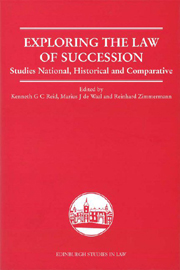Book contents
- Frontmatter
- Contents
- Preface
- List of Contributors
- List of Abbreviations
- Table of Cases
- 1 A Comparative Overview
- 2 Compulsory Heirship in Roman Law
- 3 Succession Law in Scotland – a Historical Perspective
- 4 Succession Law in South Africa – a Historical Perspective
- 5 Freedom of Testation and the Ageing Testator
- 6 Testamentary Conditions and Public Policy
- 7 Forfeiture Clauses and Events in Scots Law
- 8 Revocation of Wills by Changed Circumstances
- 9 Fideicommissary Substitutions: Scots Law in Historical and Comparative Perspective
- 10 The conditio si institutus sine liberis decesserit in Scots and South African Law
- 11 The New Dutch Law of Succession
- 12 Revocability of Mutual Wills
- 13 Succession Agreements in South African and Scots Law
- Index
2 - Compulsory Heirship in Roman Law
Published online by Cambridge University Press: 12 September 2012
- Frontmatter
- Contents
- Preface
- List of Contributors
- List of Abbreviations
- Table of Cases
- 1 A Comparative Overview
- 2 Compulsory Heirship in Roman Law
- 3 Succession Law in Scotland – a Historical Perspective
- 4 Succession Law in South Africa – a Historical Perspective
- 5 Freedom of Testation and the Ageing Testator
- 6 Testamentary Conditions and Public Policy
- 7 Forfeiture Clauses and Events in Scots Law
- 8 Revocation of Wills by Changed Circumstances
- 9 Fideicommissary Substitutions: Scots Law in Historical and Comparative Perspective
- 10 The conditio si institutus sine liberis decesserit in Scots and South African Law
- 11 The New Dutch Law of Succession
- 12 Revocability of Mutual Wills
- 13 Succession Agreements in South African and Scots Law
- Index
Summary
INTRODUCTION
All modern legal systems in Europe attempt to balance the moral precept of family solidarity with the principle of freedom of testation. But they do so in different ways. In German law, for example, the closest relatives are given the right to claim a “compulsory portion” (Pflichtteil) of the estate. The idea of a certain part of the estate having to go to the deceased's closest relatives even against his wishes dates back to Roman law. Down to the end of the nineteenth century, the Roman rules were still applicable in those parts of Germany that were governed by the ius commune. They were modified and rationalised by the draftsmen of the German Civil Code of 1900 (BGB), but the general idea on which they were based remained unaffected. The formulation provided by the BGB was not uncontroversial, either then or later. Predominantly, however, it has been and remains accepted. Today, the indefeasible claim of the closest relatives to a share of the estate is, like the principle of freedom of testation, widely taken to be guaranteed by art 1411 of the German Constitution (“Property and the right of inheritance are guaranteed”).
The present chapter provides an overview of the development of the idea of a right to obtain part of the estate even contrary to the will of the testator. It deserves our attention not only because it is the historical root of the compulsory portion of modern law, but also as a relatively well-documented example of the struggle to find reasonable solutions within the area of tension created by the two principles mentioned above.
- Type
- Chapter
- Information
- Exploring the Law of SuccessionStudies National Historical and Comparative, pp. 27 - 48Publisher: Edinburgh University PressPrint publication year: 2007



